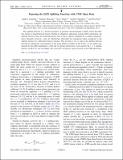| dc.contributor.author | Larkoski, Andrew | |
| dc.contributor.author | Marzani, Simone | |
| dc.contributor.author | Thaler, Jesse | |
| dc.contributor.author | Tripathee, Aashish | |
| dc.contributor.author | Xue, Wei | |
| dc.date.accessioned | 2017-10-11T11:14:14Z | |
| dc.date.available | 2017-10-11T11:14:14Z | |
| dc.date.issued | 2017-09 | |
| dc.date.submitted | 2017-07 | |
| dc.identifier.issn | 0031-9007 | |
| dc.identifier.issn | 1079-7114 | |
| dc.identifier.uri | http://hdl.handle.net/1721.1/111834 | |
| dc.description.abstract | The splitting function is a universal property of quantum chromodynamics (QCD) which describes how energy is shared between partons. Despite its ubiquitous appearance in many QCD calculations, the splitting function cannot be measured directly, since it always appears multiplied by a collinear singularity factor. Recently, however, a new jet substructure observable was introduced which asymptotes to the splitting function for sufficiently high jet energies. This provides a way to expose the splitting function through jet substructure measurements at the Large Hadron Collider. In this Letter, we use public data released by the CMS experiment to study the two-prong substructure of jets and test the 1→2 splitting function of QCD. To our knowledge, this is the first ever physics analysis based on the CMS Open Data. | en_US |
| dc.description.sponsorship | United States. Department of Energy (Grant DE-SC- 00012567) | en_US |
| dc.description.sponsorship | United States. Department of Energy (Grant DE-SC-00015476) | en_US |
| dc.language.iso | en_US | |
| dc.publisher | American Physical Society | en_US |
| dc.relation.isversionof | https://doi.org/10.1103/PhysRevLett.119.132003 | en_US |
| dc.rights | Article is made available in accordance with the publisher's policy and may be subject to US copyright law. Please refer to the publisher's site for terms of use. | en_US |
| dc.title | Exposing the QCD Splitting Function with CMS Open Data | en_US |
| dc.type | Article | en_US |
| dc.identifier.citation | Larkoski, Andrew et al. “Exposing the QCD Splitting Function with CMS Open Data.” Physical Review Letters 119, 13 (September 2017): 132003 © 2017 American Physical Society | en_US |
| dc.contributor.department | Massachusetts Institute of Technology. Center for Theoretical Physics | en_US |
| dc.contributor.mitauthor | Thaler, Jesse | |
| dc.contributor.mitauthor | Tripathee, Aashish | |
| dc.contributor.mitauthor | Xue, Wei | |
| dc.relation.journal | Physical Review Letters | en_US |
| dc.eprint.version | Final published version | en_US |
| dc.type.uri | http://purl.org/eprint/type/JournalArticle | en_US |
| eprint.status | http://purl.org/eprint/status/PeerReviewed | en_US |
| dspace.orderedauthors | Larkoski, Andrew; Marzani, Simone; Thaler, Jesse; Tripathee, Aashish; Xue, Wei | en_US |
| dspace.embargo.terms | N | en_US |
| dc.identifier.orcid | https://orcid.org/0000-0002-2406-8160 | |
| dc.identifier.orcid | https://orcid.org/0000-0002-6809-7545 | |
| mit.license | PUBLISHER_POLICY | en_US |
| mit.metadata.status | Complete | |
